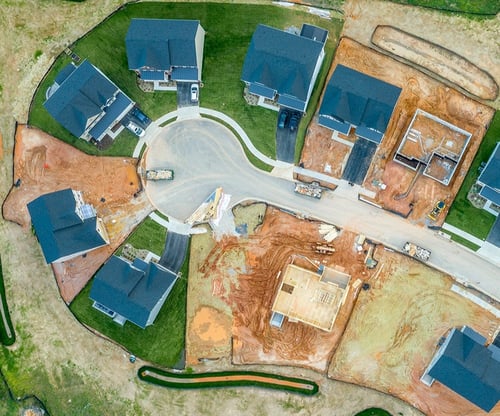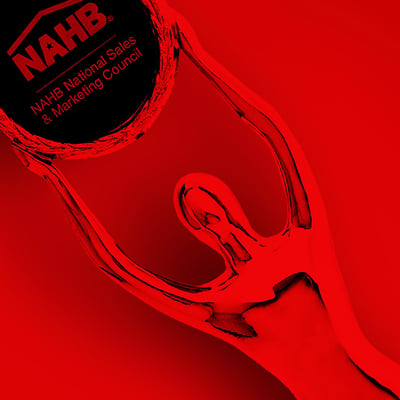Looking for a comprehensive guide for all things master-planned community marketing? You’re in the right place.
DOWNLOAD
Master-planned communities cannot be approached from one single lens. It takes communication between land developers, home builders and the marketing team to build something incredible and tell its story.
The story behind the community — and how it is communicated — is critical to its success. However, understanding how to get people interested in your community is far more complex than a few email blasts and billboards. It begins with the community— its personality, amenities, and defining features — before using immersive storytelling and creative design to speak to potential home buyers.
This free, DOWNLOADABLE comprehensive guide will discuss master-planned community marketing and how to take your community From Land to Brand. Let’s get to it!
TABLE OF CONTENTS
- Why is Research Important for Master-Planned Community Marketing?
- How Land Planners & Developers Collaborate on Master-Planned Communities
- Bring Your Master-Planned Community To Life With Creative Placemaking
- Naming Your Master-Planned Community
- How to Successfully Design and Market a Master-Planned Community
- How to Market Your Master-Planned Development Before Construction Sales Begin
- 3 Steps to Master-Planned Community Brand Differentiation
- How to Build a Marketing Budget for a Master Planned Community Marketing
- The Importance of Builder Co-Op Programs for Master Planned Community Marketing
- How Public Relations Benefit Your Master-Planned Community Marketing
- What Do Award-Winning Master-Planned Communities Have in Common?

Research plays a crucial role in marketing master-planned communities, as it provides valuable insights to reduce risk, identify opportunities and establish value. For land development and designers, access to relevant data is essential for compelling marketing campaigns and ultimately successful sales.
One of the main reasons that research is vital for a master-planned community is that any misalignment in the four Ps of marketing—product, place, price, and promotion—may result in a community that takes years to sell and misses out on potential profits. By conducting research early on, developers evaluate the feasibility and profitability of a new home community before purchasing the property and investing in development or marketing efforts.
Research firms assist in strategic planning by minimizing investment risks, identifying threats and opportunities, and saving time on data collection. They also help evaluate the business for continued growth and enable real estate developers to stay ahead of the competition.
Collaboration between land planners and land developers is crucial for the successful development of master-planned communities. Land planners and developers work together to forge communities that offer a complete lifestyle experience for homeowners, incorporating various housing types, amenities and environmental considerations.
Land planners utilize their expertise in placemaking to differentiate the community and create a unique identity. They focus on creating public spaces, promoting walkability, incorporating mixed-use development, prioritizing sustainability and fostering community engagement. By considering these elements, land planners bring the community to life and design a sense of place that resonates with residents.
Understanding lots, sizing, pricing, as well as city and county requirements and zoning regulations, plays a significant role in the collaboration between land planners and developers.
Community amenities are an integral part of the master-planned community vision. Land planners identify opportunities for amenities such as schools, parks, mixed-use spaces and transportation infrastructure. These amenities contribute to the community’s overall appeal and attract prospective homebuyers.
By working together, land planners and developers create thriving communities that meet the needs and preferences of future residents. Partnering with branding and marketing experts enhances the community’s outreach by effectively reaching the target audience and maximizing absorption rates.
Creative placemaking is a powerful tool for bringing master-planned communities to life and enhancing homeowner lifestyles. It involves strategic planning, design and development of public spaces within the community. By efficiently utilizing space and creating inviting common areas, developers offer several benefits to homeowners, such as reduced crime rates, increased property values and improved overall well-being.
Placemaking is about more than just the physical environment—it is about creating a sense of community and connection. When homeowners envision themselves living in a community that offers not just a house but a destination, they are more likely to be attracted to the development. Thoughtful interior merchandising within homes and the presence of community spaces that encourage interaction and engagement contribute to a sense of belonging and make the community more than just a place to live.

Creative placemaking also cultivates inclusivity by considering the residents’ diverse needs and interests. By creating accessible spaces and amenities, developers ensure that everyone in the community enjoys and benefits from the available facilities. This fosters a sense of community and enhances the community’s desirability.
In the context of marketing master-planned communities, creative placemaking enhances the overall appeal of the development. It differentiates the community from competitors, adds value, and provides tangible benefits for residents and the environment. By showcasing the potential of the community through branding and marketing efforts, developers attract the target market and construct a strong brand identity.
Naming a master-planned community is a critical step in marketing and branding efforts. The name sets the tone for the development, creates a first impression and helps differentiate it from competitors. A strong community name resonates with potential homebuyers and evokes emotions that connect them to the community.
Choosing a compelling name involves considering the community's unique Brand DNA, target market, location, amenities and desired lifestyle. A well-chosen name captures attention, sparks curiosity and adds value to the development. It becomes a memorable aspect of the branding and marketing strategy.
Qualities of an effective name:
MEANINGFUL
It tells a story. It communicates something about the essence of the community. It supports the image that the community wants to convey.
DISTINCTIVE
It invites exploration. It is unique, as well as easy to remember, pronounce, and spell. It is differentiated from the competition.
FUTURE-ORIENTED
It positions the community for growth, change, and success. It has sustainability and preserves possibilities.
MODULAR
It enables the community to build brand extensions with ease.
PROTECTABLE
It can be owned and trademarked. A domain is available.
POSITIVE
It has positive connotations in the markets served. It has no strong negative connotations.
VISUAL
It lends itself well to graphic presentation in a logo, in text, and in brand architecture.
Designing and marketing a master-planned community involves more than just creating the physical infrastructure. It requires a comprehensive approach encompassing branding, storytelling and understanding the target audience. Building a community does not guarantee that buyers will come; effective marketing strategies are essential.
Thriving master-planned communities incorporate key design elements that appeal to today's homebuyers. These elements include strong placemaking, creating a sense of belonging and comfort within the community. A clear brand identity and theme work together to establish a unified narrative and cohesive branding throughout the community. Desirable lifestyle amenities, such as health and wellness facilities, outdoor living spaces, and social activities, cater to buyers' needs and foster a sense of community.
Branding and marketing play a significant role in attracting homebuyers to the community. Developing a unique identity and brand promise that aligns with the target audience's values and aspirations is essential. Conducting market research helps understand the competitive landscape, industry trends and buyer expectations, providing a competitive edge.
Telling a compelling story is a vital component of branding and marketing. It goes beyond listing the community's features and benefits; it paints a picture of the lifestyle and experiences the community offers. Engaging in conversations and interactions with the target audience helps build relationships and allows buyers to envision themselves as part of the community's narrative.
To succeed, exceptional master-planned communities need both outstanding design and compelling marketing strategies. Combining thoughtful design elements with compelling branding and storytelling ensures that the community stands out and resonates with homebuyers.
Marketing a master-planned community before the builders are ready to begin sales requires thoughtful pre-sale strategy and execution. While the construction is underway, it is essential to establish a strong brand identity and marketing strategy to attract potential homebuyers and and generate interest in the community.
When marketing a master-planned community before homes are on the market, there are two primary groups to target: Realtors and prospective homebuyers. Building solid relationships with real estate agents is crucial for two reasons:
- Realtors have buyers. Realtors represent over 75% of all real estate transactions in the market.
- Realtors Influence buyers. Realtors have a significant influence over where buyers look for homes, what homes they consider and what home they eventually purchase.

Engaging with prospective homebuyers requires strong messaging that conveys the community's lifestyle opportunities and matches their needs.
Amplifying the virtual voice of the community is essential to reach a broader audience. Utilizing a strategic mix of digital tactics including paid search, paid social media ads, email marketing, display marketing, and search engine optimization (SEO) strategies increase the visibility of the community's online content and drive traffic to the website.
By implementing a comprehensive marketing strategy pre-construction, developers generate interest, build brand recognition and establish a strong backlog of home buyers for future sales.
Differentiating your master-planned community from others in the market helps attract homebuyers and ensures long-term success. Milesbrand offers a three-step proprietary approach to master-planned community brand differentiation to generate a unique and memorable brand identity.
The first step in the process is the Brand Charrette, where Milesbrand's team learns about the planned development, including the developer's values, the land planner's vision, the home builder's product mix, and the target homebuyer profiles. This step focuses on understanding the brand DNA of the community and lays the foundation for the branding strategy.
The second step is Brand Positioning, where customer and resident-facing elements are developed to give the community a distinct theme. This includes naming the community with a meaningful and appealing name, creating a brand promises that emphasize the community's unique characteristics, developing a brand personality that resonates with the target audience, and crafting a positioning statement that clarifies the community's value proposition, and a strong graphic identity that visually differentiates the community from competition.
Once the brand positioning is established, the third step is the Brand Plan, which involves launching the new brand for the master-planned community. This includes implementing a go-to-market plan spanning several years and outlining budgets, tactics, and timelines for community marketing. The launch is designed to generate excitement and buzz among prospective homebuyers and realtors, creating a backlog of buyers for the community even before the models, homes and amenities are completed.
Taking a proactive approach to brand differentiation is essential for the success of a master-planned community. By partnering with Milesbrand and going From Land to Brand, you develop a unique and irreplicable community identity that sets you apart from the competition.
Creating a marketing budget for a master-planned community is needed to effectively reach and engage the target audience. It allows developers and home builders to strategically invest in various marketing tactics and maximize return on investment (ROI). Here are some guidelines to help build a marketing budget for a master-planned community.
Finding the Right Balance: When determining the marketing budget, it's important to strike the right balance. The National Association of Home Builders recommends allocating 1 to 1.5% of the projected sales volume for the community to build a budget.
Example: Community A
This hypothetical community will feature:
- Total number of homes for sale: 800
- 4 builders
- Each builder will create product for different market segments
- This will reduce internal competition between builders
- Multiple products for multiple market segments building at the same time will increase absorption
- Average price per home: $500,000
- Projected sales per year: 175 = 4.5 years to complete
- 800 homes sales x $500,000 average price = $400,000,000
- $400,000,000 / .01% = $4,000,000 marketing budget
Budget Breakdown: The marketing budget should cover various elements to promote the master-planned community to the fullest. This includes branding, online presence, advertising (both digital and offline media), content marketing, visual representation (photography, videos, virtual tours), collateral (brochures, floorplans, etc.), branded items, listing services, signage, sales center, events, marketing team and Realtor outreach. Each of these elements plays an important role in attracting and engaging homebuyers.
By following these guidelines and investing in a well-thought-out marketing budget, developers and home builders maximize marketing efforts and effectively promote their master-planned community to the right audience.
Builder co-op programs offer numerous advantages for home builders participating in the community. These programs allow builders to collaborate on a large-scale project, resulting in increased name recognition and a wealth of marketing opportunities.
The developer of a master-planned community typically initiates a builder co-op program to fund the marketing budget. Each builder participating in the program contributes a prorated portion of their sales to support a comprehensive marketing strategy from the community's launch to its final sale. By pooling resources, builders benefit from reduced costs and can implement impactful marketing strategies that target a broader audience.
One of the primary advantages of a builder co-op program is cost savings. With multiple builders sharing the marketing expenses, the burden on each individual builder is significantly reduced. This allows for more robust marketing efforts without straining the budgets of individual builders. Furthermore, the combined contributions from all builders result in a larger overall marketing budget, enabling the community to implement sophisticated strategies and reach a wider audience.
A larger marketing budget provides opportunities to craft compelling storytelling that resonates with the target audience. By persuasively showcasing the lifestyle and unique features of the community, master-planned community marketing attracts homebuyers and creates a sense of desirability. Using engaging narratives and consistent branding across various marketing channels, including digital and advertising, social media, and community signage, further strengthens the community's appeal.
Public relations (PR) plays a crucial role in shaping the reputation and public perception of home builders and developers in master-planned communities. By effectively managing the brand's image and visibility, PR efforts contribute to enhanced credibility and increased buyer trust.
Many builders and developers mistakenly believe that PR is only necessary for large companies or when dealing with negative attention or crises. However, PR is valuable for any company, regardless of size or reputation. By sharing insights, expertise, and updates, PR helps build goodwill and a positive reputation for the brand.
PR is often underestimated in the homebuilding industry, but it offers numerous benefits for master-planned community marketing. One of the key advantages is building brand awareness and credibility. PR efforts, such as securing media placements, help increase the visibility of the brand in front of the target audience. Compared to paid advertising, earned media through PR carries more trust and validates the company's expertise, establishing greater credibility with potential buyers.
Effective PR strategies can also help reduce marketing costs. Integrating PR with other marketing tactics, such as owned media and paid media, allows builders and developers to achieve greater impact at a lower cost. Sharing company news through earned media placements is a cost-effective way to reach the target audience.
Award-winning master-planned communities share common characteristics that contribute to strong sales. These communities understand the significance of marketing a master-planned community, employ strategies that exceed homebuyer expectations and establish compelling, award-worthy communities.
Marketers face the challenge of creating a differentiated brand that resonates with homebuyers and convinces them that the community is the best place to call home. Buying a home is an emotional and significant investment for homebuyers, and marketers must tap into those emotions to promote a compelling case for choosing their community. Creating a brand that matches the emotional weight of such a purchase is crucial.
Award-winning master-planned communities focus on capturing the vision of prospective homebuyers and exceeding their expectations. They use techniques that appeal to the heart of their target audience. Memorable branding is a critical aspect, where the community's unique differentiators are emphasized to generate a sentimental connection with homebuyers. Creative marketing of amenities goes beyond listing features and paints a picture of how the amenities enhance residents' lives. Impactful storytelling produces an emotional connection with homebuyers, while original photography adds authenticity and helps homebuyers visualize themselves living in the community. Omnichannel marketing ensures a consistent message is delivered to prospective homebuyers across all channels, enhancing the customer experience.
Master-planned communities that have achieved award-winning status understand the importance of these strategies. They go beyond mere marketing tactics and focus on creating a brand that resonates with homebuyers, meets their expectations and offers a desirable lifestyle. By employing these techniques, these communities stand out from the competition and create memorable experiences for their residents..

Here at Milesbrand, we stand by this approach to master-planned community marketing for a simple reason — it works. Our experience in real estate marketing spans multiple decades, and we have seen countless successful communities emerge from these campaigns.
Though effective, the process is also incredibly complex and laborsome. It takes patience, expertise, and alignment to bring a master-planned community to life. Thankfully, that’s what our team of marketers enjoys most. If you need more information on our master-planned community marketing capabilities, reach out to us today. We can’t wait to get started!
